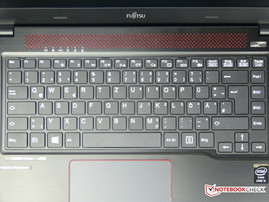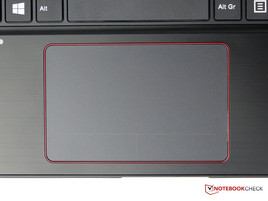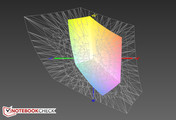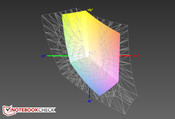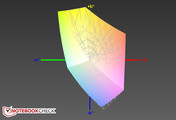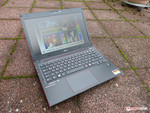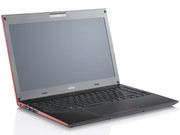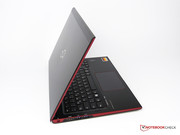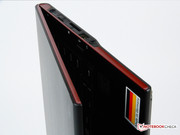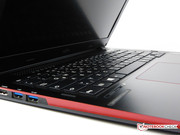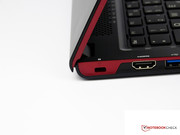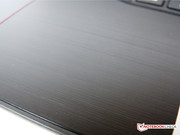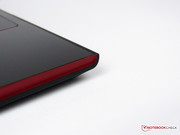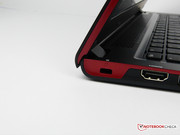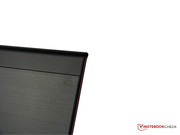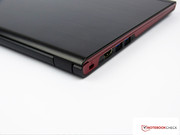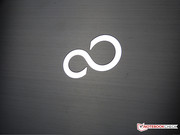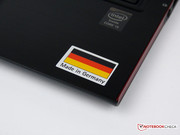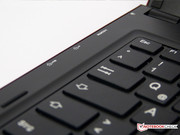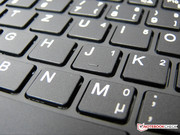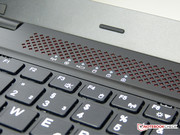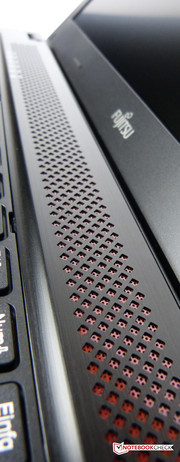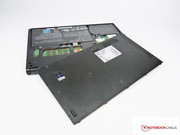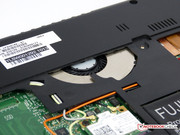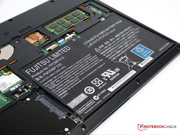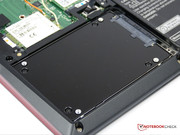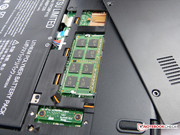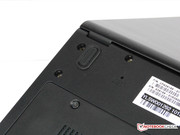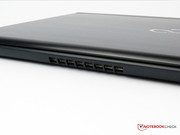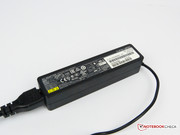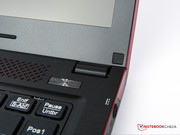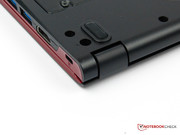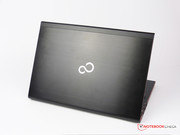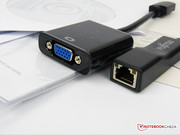Review Fujitsu Lifebook U554 Notebook

For the original German review, see here.
Fujitsu complements its U-series with another subnotebook, the Lifebook U554. It is equipped with an Intel Core i5-4200U and 8 GB DDR3 memory. The matte LED display should provide a convenient working environment, and the reserved but especially thin black-red design supports the ultrabook ambitions of our review unit.
The competition is just as big as their price range: While comparatively few notebooks use an Intel Core i5 from the Haswell generation so far, the selection of devices with processors from the last generation is quite extensive. That is also the reason we use Samsung's Series 5 530U3C as well as Dell's Vostro 3360 (both i5-3317U) besides Lenovo's IdeaPad U330p (Intel Core i5-4200U) for comparison. Both Ivy Bridge devices are also available with the more powerful Core i7-3537U, but our review units were equipped with the Core i5.
One editorial note: There are a large number of devices with similar hardware equipment. We listed them under The competition in the right column.
Case
Fujitsu uses a mixture of aluminum and plastic both for the base unit as well as the display cover of the Lifebook U554. However, we can bend and twist both parts with some force because of the compact dimensions and the thin chassis. This is especially evident at the base unit in the area between the hinges. The overall stability on the other hand is reasonable for the low weight and the thin design of the U554. The display hinges keep the display in position well, but the screen still tends to wobble with vibrations due to the poor torsion resistance.
The build quality on the other hand can completely convince us: Gaps are very small and we could not determine any problems. Red stripes on the sides of the subnotebook are a nice contrast and are well integrated.
Connectivity
The design of the case gets thinner towards the front, so all the ports of our review unit are located in the rear area on both sides. All bulky ports, for example the two USB 3.0 ports as well as the HDMI port, have been placed at the left side (to the delight of right-handers). One additional USB 2.0 port, the SIM card slot for the integrated WWAN module and the power connector are located at the right side. An Ethernet cable can only be used via adaptor, which is provided by the manufacturer.
Communication
Besides Bluetooth, the U554 can also use wireless Internet via WLAN or integrated WWAN module. We did not encounter any problems with either of the cards; the WLAN performance was still acceptable through a concrete ceiling. Ethernet can only be used with the provided USB-LAN adaptor; the maximum transfer rate is limited to 100 Mbps.
Security
Fujitsu only integrates a Kensington Lock besides the integrated TPM module - another security feature, for example a fingerprint reader, is not available.
Accessories
Our review unit comes with several accessories: Besides the usual quick start guides and warranty information, the scope of delivery also includes a driver and a recovery DVD. You also get the already mentioned LAN adaptor, which can be attached to a USB port. A second adaptor, this time from HDMI to VGA, is also in the box.
Maintenance
We can only remove and replace the battery of our review unit after we loosen several Torx screws; the same applies for the SSD and the memory module. You will need a Phillips screwdriver if you want access to the other components. Overall maintainability of our review unit is comparatively good, even beginners should not have a problem to open the subnotebook.
Warranty
The input of the serial number on Fujitsu's homepage reveals a three-year Bring-In warranty, which can be extended with several warranty packages.
Input Devices
Keyboard
Fujitsu equipped our review unit with a black chiclet keyboard, which shows some flexing during intense typing. The keys actually have a clear pressure point and sufficient travel - but the whole typing experience of our review unit is affected by two particular keys. The key with the letter L has such a wobbly pressure point that we often activated it accidentally and our fingers would sometimes slip off it towards other keys.
The situation is similar for the J key: It actually reminds us of a sinking vessel because it is so tilted. Users with large hands could also have some problems because the whole keyboard was cramped together (keyboard width Edge E135: 265 mm, Logitech G510: 270 mm, U554: 258 mm) (~10.4, 10.6, 10.2 inches respectively).
The keyboard would get a good rating if it were not for the two mentioned keys. We could not yet determine if this is an isolated problem of our review unit or a general issue.
Touchpad
Contrary to the keyboard, the touchpad of our review unit does a good job. Even though Fujitsu does not use separate buttons for left and right clicks, respectively, the recognition at the bottom of the touchpad was very reliable. The necessary force to activate the additional resistive pressure point on the whole surface gets higher towards the upper edge of the pad. This phenomenon is however very common for notebooks and does therefore not have a serious effect on the rating, especially since the additional pressure point is not used very often.
Display
Our review unit is equipped with a matte panel with LED backlight from LG Philips. It has a resolution of 1366x768 pixels and a maximum brightness of 226 cd/m².
The average result is only 199 cd/m² and many panels of mainstream subnotebooks are on a similar level. Our rivals are very far and slightly behind with 98.6 cd/m² and 177.2 cd/m², respectively (IdeaPad U330p and Vostro 3360). Samsung's Series 5 530U3C on the other hand is significantly brighter with 306.6 cd/m². The brightness distribution of 81% is reasonable for a mainstream device and there are no visible brightness differences. Considering the price of the device (also see Verdict), users can expect a better display.
| |||||||||||||||||||||||||
Brightness Distribution: 81 %
Center on Battery: 225 cd/m²
Contrast: 257:1 (Black: 0.88 cd/m²)
ΔE ColorChecker Calman: 9.99 | ∀{0.5-29.43 Ø4.78}
ΔE Greyscale Calman: 10.43 | ∀{0.09-98 Ø5}
36.1% AdobeRGB 1998 (Argyll 1.6.3 3D)
37.27% AdobeRGB 1998 (Argyll 3D)
54% sRGB (Argyll 3D)
36.04% Display P3 (Argyll 3D)
Gamma: 2.63
CCT: 12905 K
The same applies for the contrast and the black value: Both are typical for a mainstream panel with 257:1 and 0.88 cd/m². Dell's Vostro 3360 is slightly worse and users of the Samsung Series 5 530U3C have to live with a poor black value and contrast ratio (2.47 cd/m² and 130:1, respectively). The U330p has better results - but the exceptionally dark display is far behind the competition.
Neither the AdobeRGB nor the sRGB color spaces are covered by the U554 (51.58% and 36.1%). These values are however only important for professional picture editing and the rivals are not better either.
The DeltaE results are more interesting and give some information about the color accuracy of the matte panel. We can see high deviations with average values of 10.43 and 9.99, respectively (color / gray); gray, in particular, looks more like blue (compare screenshots). The color accuracy of the U554 is therefore not good, even devices that are a couple hundred Euros cheaper often show better results.
The viewing angle stability of the U554 meets the expectations for a TN panel: Inverted colors are a problem both with vertical as well as horizontal viewing angles starting at around 30°. You can obviously work with the display, but a relaxing movie night with the 13-inch device should be limited to one or two persons at most.
Performance
The hardware specs of our review unit represent a typical ultrabook: A Low-Voltage processor in combination with the lack of a dedicated GPU should enable longer battery runtimes, while 8 GB memory and the mentioned Core i5-4200U should provide sufficient system performance. Fujitsu cannot call the U554 an ultrabook because it does not have a touchscreen; it is only available in the sibling Lifebook U574.
Processor
The integrated i5-4200U has two processor cores with a nominal clock of 1.6 GHz each, which can be raised up to 2.3 GHz for both cores or 2.6 GHz for one core via Turbo Boost to increase the performance if necessary. The TDP of 15 Watts reduces the energy consumption to improve the battery runtimes.
Both the results for Cinebench R10 as well as Cinebench R11.5 suggest a throttling issue with our review unit: While the notebook gets similar scores to other rivals with the same hardware equipment (like the U330p, Vaio Duo 13 or Latitude E7240) in both Single-Core benchmarks, it does not stand a chance in the Multi-Core benchmarks. While the U330p is 12% ahead of our review unit with 6,235 points in Cinebench R10 Multi 32-bit, the Ativ Book 9 is more than 40% faster (7,796 points) than our U554 with only 5,565 points. This situation does not change in the other Multi-Core benchmarks (see chart below).
We will have a closer look at the throttling problem in the Temperature section later in this review.
System Performance
We use the tools PCMark Vantage and PCMark 8 to determine the general system performance. The individual tests simulate and evaluate different usage scenarios.
Our review unit gets 9,125 points in PCMark Vantage and therefore more than the U330p (7,554 points), the Dell Vostro 3360 (6,650 points) or the Samsung Series 5 530U3C (6,855 points). One reason for this advantage should be the SSD; the HDD score of 46,341 points is comparatively high (U330p: 17,014 points).
PCMark 8 however shows another picture: While our device is on the same level with the other rivals, which are equipped with the same CPU and GPU, in the Home test, it cannot keep up in the Creative and Work tests. The U554 manages 1,173 and 2,474 points, respectively, in these two tests, while one of the worst devices in our comparison, the HP ProBook 430-G1, gets 2,247 and 4,140 points; thermal throttling is once again the problem. The subjective system performance however is not affected by that, except for scenarios with maximum system load, for example our stress test.
| PCMark Vantage Result | 9125 points | |
| PCMark 8 Home Score Accelerated | 2580 points | |
| PCMark 8 Creative Score Accelerated | 1173 points | |
| PCMark 8 Work Score Accelerated | 2474 points | |
Help | ||
Storage Solution
There is not much to tell about the hard drive of the Fujitsu Lifebook U554: The integrated Samsung SSD with a capacity of 256 GB does an excellent job and is often within the top 25 of around 1,000 reviewed notebooks.
AS SSD shows 510.9 MB/s (sequential read) and 249.35 MB/s (sequential write) for the Samsung SSD 840. The 4K-Test of CrystalDiskMark, which moves a lot of small data blocks, results in 30.07 and 96.07 MB/s (read / write). This is once again a top 25 result for the SSD. The average transfer rate according to HD Tune is 431.9 MB/s and therefore place 21 of 1,878.
Graphics
The thermal throttling of the CPU seems to affect the integrated Intel HD Graphics 4400 as well. While our review unit is average with 5,030 points in the 3DMark Cloud Gate benchmark, the results of the Physics benchmarks of IceStorm and Cloud Gate are downright disastrous: Even the worst notebook we reviewed thus far (Vaio Pro 11, similar components) has an advantage of 72% and 87%, respectively, with 21,905 and 2,149 points (Lifebook U554: 12,750 / 1,150 points).
The same applies for the other GPU benchmarks; our U554 cannot keep up with similarly equipped competitors. The subnotebook manages 29,394 points in the Ice Storm Graphics benchmark, only the Vaio Pro 11 (24,032 points) is worse. Sony's Vaio Duo is the best device with 37,709 points. 3DMark Vantage shows a similar situation, but the Vaio Pro 11 is actually ahead or at least on one level with our review unit in this case. We could not determine a performance reduction on battery power, for neither the GPU nor the CPU.
| 3DMark | |
| 1280x720 Ice Storm Standard Physics (sort by value) | |
| Fujitsu Lifebook U554 | |
| Sony Vaio Duo 13 SVD1321M2E | |
| Sony Vaio Pro 11 SVP121M2EB.G4 | |
| 1280x720 Ice Storm Standard Graphics (sort by value) | |
| Fujitsu Lifebook U554 | |
| Sony Vaio Duo 13 SVD1321M2E | |
| Sony Vaio Pro 11 SVP121M2EB.G4 | |
| 3DMark Vantage P Result | 2450 points | |
| 3DMark Ice Storm Standard Score | 22784 points | |
| 3DMark Cloud Gate Standard Score | 2874 points | |
Help | ||
Gaming Performance
Occasional gaming is possible with the U554 - but you should focus on some older games. Even though Counter Strike: Global Offensive, for instance, is playable on the subnotebook with almost 35 frames per second, the actual gaming experience is much worse with many dropped frames. You should not even try Company of Heroes 2, even the lowest settings resulted in less than 8 fps; only Grid 2 was somewhat playable with 23.8 fps.
| low | med. | high | ultra | |
|---|---|---|---|---|
| Counter-Strike: GO (2012) | 34.95 | 23.26 | 17.75 | |
| GRID 2 (2013) | 23.9 | 17.1 | 14.1 | |
| Company of Heroes 2 (2013) | 7.83 | 7.8 |
Emissions
System Noise
We are satisfied with the system noise of the subnotebook in general - the fans are usually deactivated during idle or with light workloads; only heavy workloads and the start-up (the notebook reaches 46.0 dB(A) for a short time) result in noisy 41.2 dB(A). We could not determine any annoying noises like high tones and there is no hard drive that could create any noise.
Noise level
| Idle |
| 29.5 / 29.5 / 29.5 dB(A) |
| Load |
| 36.3 / 41.2 dB(A) |
 | ||
30 dB silent 40 dB(A) audible 50 dB(A) loud |
||
min: | ||
Temperature
We use our stress test, which stresses all components, to determine the maximum surface temperatures of our notebook. We can measure a maximum temperature of 46 degrees Celsius (114.8 degrees Fahrenheit) at the top and 47.8 degrees Celsius (118.04 Fahrenheit) at the bottom, in both cases in the area around the fan exhaust. The situation is much better with normal workloads, using the device on your lap is no problem at all.
We already mentioned the serious thermal throttling in our CPU section and our stress test confirms the problem: The CPU clock is lowered to 798 MHz after just one minute at maximum load. We suspect a too cautious throttling; the CPU could easily manage more than the 83 degrees Celsius (181.4 Fahrenheit) in our stress test. Cinebench R11.5 also shows the throttling with a fluctuating clock between 798 MHz and 1.96 GHz.
The temperatures during idle are no problem: 31.2 degrees Celsius (88.16 Fahrenheit) is not very warm.
(-) The maximum temperature on the upper side is 46 °C / 115 F, compared to the average of 35.9 °C / 97 F, ranging from 21.4 to 59 °C for the class Subnotebook.
(-) The bottom heats up to a maximum of 47.8 °C / 118 F, compared to the average of 39.3 °C / 103 F
(+) In idle usage, the average temperature for the upper side is 27.1 °C / 81 F, compared to the device average of 30.8 °C / 87 F.
(+) The palmrests and touchpad are cooler than skin temperature with a maximum of 28.2 °C / 82.8 F and are therefore cool to the touch.
(±) The average temperature of the palmrest area of similar devices was 28.2 °C / 82.8 F (0 °C / 0 F).
Speakers
The speakers of our review unit produce a slightly tinny and flat sound. High tones on the other hand are comparatively clear and rich but tend to distort in some cases. As expected, there is no bass at all - but the overall sound experience is okay for a subnotebook. We noticed some occasional background noises during several videos and sound files.
Energy Management
Power Consumption
The Lifebook U554 is more frugal than its direct rivals using only 3.5 Watts during idle; even the IdeaPad U330p consumes almost twice as much using 6.1 Watts. We can definitely see the effect of the SSD, which needs less energy than a conventional hard drive. Our stress test with maximum load results in 27 Watts for both devices. We can see a drop to 12.6 Watts after a while due to the throttling issues.
| Off / Standby | |
| Idle | |
| Load |
|
Key:
min: | |
Battery Runtime
The bad CPU performance does however improve the battery runtimes: 2:34 hours in the Battery Eater Classic Test are better than the three mentioned rivals; Samsung's Series 5 530U3C comes in second place with 2:12 hours. This test stresses both the CPU and the GPU. The situation is similar in all the other scenarios, none of the competitors can keep up with our review unit that manages 6:43 hours in the WLAN Test and 14:48 hours in the Battery Eater Reader's test. The last test was performed with minimum display brightness; the luminance in this setting is however so low that it can be difficult to see the display content, even in a very dark environment.
Verdict
Our time with the Fujitsu U554 leaves us with mixed impressions. In other words, all that glitters is not gold. The subnotebook is very good in some aspects but there are definitely some drawbacks. Two features of the almost-ultrabook are especially good: First of all the long battery runtimes, no competitor can keep up in this category. The other thing is the 256 GB Solid State Drive: It only takes two seconds before we can see the Windows 8 Metro-UI.
However, let's get back to the saying: The Lifebook U554 literally does not shine with its matte display that has an acceptable brightness of around 200 nits. The case can also convince us, at least the design. The build quality is good but there are some stability issues.
But there are also two serious drawbacks: Both the problem with the keyboard and the throttling of the processor are not a good sign, especially after the manufacturer sent us a mail with the retail price: More than 1,500 Euros (~$2017) - and this is without VAT - so the end user has to pay around 1,800 (~$2421) Euros for the device. You should think hard about that.
Alternatives in this price range would be the Samsung Series 9 900X3C or the ATIV Book 9; both devices do not have many drawbacks. The same applies for the Lenovo ThinkPad X1 Carbon or the Dell Latitude E7440. Another less expensive alternative from Dell, even though with a shorter battery runtime, is the Vostro 3360. If you can live with a worse black value and contrast, the Samsung Series 5 530U3C might also be worth a look. Very light but unstable in return is the Sony Vaio Pro 13. Last but not least, there is also a cheaper alternative from Fujitsu, the Fujitsu UH572. The final decision is certainly not an easy one.






